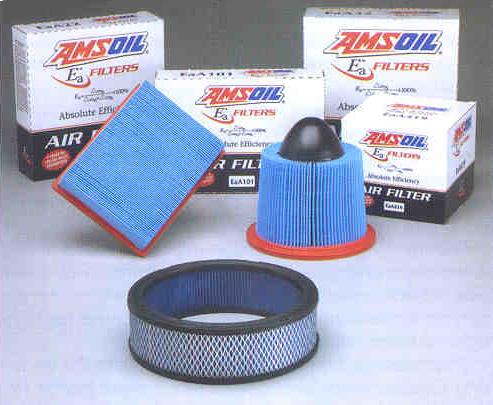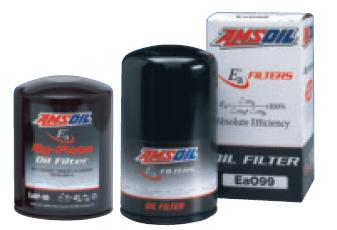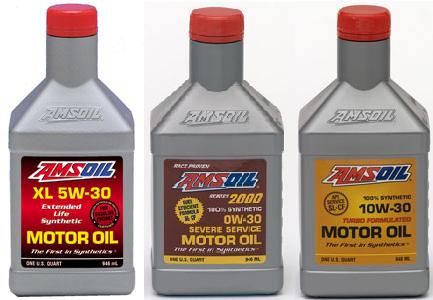Extended Service Intervals Will Stretch your Dollar
Keep copies of your oil analysis reports. One owner-operator had a warranty claim denied because he went 58,000 miles without an oil change (using synthetic oil and a wrapped-media by-pass filter) when a con-rod bushing broke. He brought out a stack of analysis reports and asked, "Which of these shows that I should have changed oil?" His warranty was honored.

As long as engine oil is able to cool and lubricate and is kept clean, it doesn’t need to be changed. AMSOIL synthetic motor oils withstand the abuse of heat and engine pounding without breaking down — resulting in a vastly extended ability to last and lubricate over non-synthetic motor oils. And AMSOIL makes advanced filtration products that keep these oils analytically free of harmful engine dirt and other contaminants. By combining these sophisticated oil and filtration products with an advanced system of engine monitoring through oil analysis, AMSOIL has created the Trigard Plan of Engine Protection — a way to keep engine oil clean indefinitely. The Trigard Plan can eliminate the need for changing oil in your personal vehicle* forever. Here are the components of the Trigard Plan.
*available for cars and light trucks in noncommercial applications.
|
Superior Motor Oil
|
 |
|
Superior Air & Oil Filters Dirt is your engine’s worst enemy and the single major cause of engine wear. AMSOIL TRIGARD utilizes two extremely effective filters to keep airborne dirt from entering your engine through the engine air intake, and continuously filter contaminants and combustion by-products from the engine oil.
|
 |
|
 |
|
Superior Engine Monitoring
†12,500 miles on diesel or turbocharged vehicles. |
 |
Lubes-n-Greases Automotive Editor David McFall wrote an intriguing column on extended drain intervals in March 2003 in which he openly criticized the American motor oil market and the standard 3,000-mile oil change. He pointed to the European market, where drain intervals are generally twice as long as in the U.S., to demonstrate his point that the American motor oil market is “shackled,” and he concluded the standard 3,000-mile oil change is promoted primarily to increase motor oil sales, at the expense of consumers and the environment. McFall also took the time to praise AMSOIL INC. for its extended drain technology.
In the December 2003 issue of Lubes-n-Greases, McFall posted a follow-up column in which he further questioned the logic and responsibility behind standard 3,000-mile drain intervals. He quotes the Environmental Protection Agency as stating, “improperly disposed used oil is the largest single source of oil pollution fouling our nation’s waters.”
Considering used motor oil can have long-term negative effects on the environment, McFall finds it irresponsible for motor oil companies to continue promoting shorter drain intervals when the technology exists to produce higher quality oils capable of extended drains. “While the nuclear power industry would not support the production of excess uranium fuel,” writes McFall, “it is not inconceivable that the U.S. oil industry would support, encourage and skillfully promote excess gasoline engine oil usage, despite the harmful effects of its waste product on the environment.”
McFall supports his conclusion with three valid arguments. First, the average drain interval in Europe is twice as long as in the U.S. despite similarities in engines, motor oil and driving patterns. Second, despite three U.S. motor oil quality upgrades over the past 10 years, drain interval recommendations haven’t budged. Here, McFall commends AMSOIL again for being the single company to translate motor oil quality upgrades into extended drain intervals. Third, although many American motor oil companies say their products “exceed” oil industry specifications, they still don’t recommend drain intervals over 3,000 miles.
McFall explains that in today’s business world, some companies have had to look at their marketing techniques from an ethical standpoint, often at the expense of sales. Kraft Foods, for example, voluntarily agreed to stop selling certain unhealthy food products in schools. He wonders if the pollution consequences of used motor oil impose an ethical burden on the motor oil industry to reduce the harmful effects of this pollution, even if it results in reduced sales.
An interview with Dr. Michael Hoffman, executive director of Bentley College’s Center for Business Ethics in Waltham, Mass., helped McFall answer his question. “Any corporation that makes a product which creates exceptional hazardous effects on the environment has an increased ethical obligation to find solutions to decrease those effects,” says Hoffman. “A universal or absolute business ethics principle is to avoid causing unjustifiable harm, and to find strategies to reduce harm, especially that which is self-caused, whenever or wherever possible to do so.
 “These comments certainly
apply to used engine oil, and challenge the oil industry to demonstrate
that it is doing everything possible to meet this ethical standard.
Unfortunately, there is evidence to suggest that this is not happening.
“Furthermore,” continues Hoffman, “corporate ethical sensitivity and
social responsibility are at a high water mark today, and perhaps more
than ever before in the minds of companies’ stakeholders. So much
so, in fact, that companies which demonstrate that they have developed an
ethical edge will gain competitive edge in the market, which might be
called the business case for business ethics. The oil industry would do
well to grasp this insight and become more transparent and forthcoming
about the information it has and the progress it’s making toward
increasing the drain interval of engine oil.”
“These comments certainly
apply to used engine oil, and challenge the oil industry to demonstrate
that it is doing everything possible to meet this ethical standard.
Unfortunately, there is evidence to suggest that this is not happening.
“Furthermore,” continues Hoffman, “corporate ethical sensitivity and
social responsibility are at a high water mark today, and perhaps more
than ever before in the minds of companies’ stakeholders. So much
so, in fact, that companies which demonstrate that they have developed an
ethical edge will gain competitive edge in the market, which might be
called the business case for business ethics. The oil industry would do
well to grasp this insight and become more transparent and forthcoming
about the information it has and the progress it’s making toward
increasing the drain interval of engine oil.”
AMSOIL Synthetic Motor Oils offer unsurpassed protection and performance, while significantly reducing the effects of used motor oil on the environment. As the leader in extended drain technology, AMSOIL offers motor oils with three different drain interval recommendations. AMSOIL XL-7500 Synthetic Motor Oils offer up to 7,500-mile/six-month drain intervals, AMSOIL Synthetic Motor Oils offer up to 25,000-mile/one-year drain intervals and AMSOIL Series 2000 0W-30 Motor Oil offers up to a 35,000-mile/one-year drain interval.
David McFall’s December 2003 column “Motor Oil Drain Intervals: An Ethical Burden?” is available for download on the AMSOIL corporate website: http://www.amsoil.com/lit/lng_article/dec_03_mcfall.pdf.